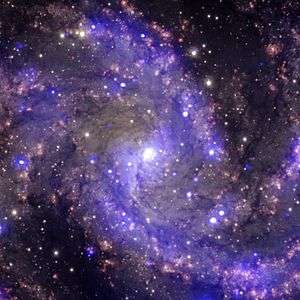NGC 6946
| NGC 6946 | |
|---|---|
|
Spiral Galaxy NGC 6946 | |
| Observation data (J2000 epoch) | |
| Constellation | Cepheus & Cygnus |
| Right ascension | 20h 34m 52.3s[1] |
| Declination | +60° 09′ 14″[1] |
| Redshift | 0.000160[1] |
| Helio radial velocity | 48 ± 2 km/s[1] |
| Distance |
22.5 ± 7.8 Mly (6.9 ± 2.4 Mpc)[2] |
| Apparent magnitude (V) | +9.6[1] |
| Characteristics | |
| Type | SAB(rs)cd[1] |
| Apparent size (V) | 11.5 x 9.8 arcmin[1] |
| Other designations | |
| UGC 11597, PGC 65001, Arp 29,[1] Caldwell 12 | |
NGC 6946 (also known as the Fireworks Galaxy, Arp 29, and Caldwell 12) is an intermediate spiral galaxy about 18 million light-years away,[2] in the constellations Cepheus and Cygnus. It was discovered by William Herschel on September 9, 1798. NGC 6946 is highly obscured by interstellar matter of the Milky Way galaxy, as it is quite close to the galactic plane. The diameter of the galaxy is approximately 40,000 light-years or just about a third of the size of the Milky Way.[3]
Supernovae
Nine supernovae have been observed in NGC 6946 in the last 100 years: SN 1917A, SN 1939C, SN 1948B, SN 1968D, SN 1969P, SN 1980K, SN 2002hh, SN 2004et, and SN 2008S.[4] This makes it the most prolific known galaxy for this type of event over a period of 100 years. By comparison, the Milky Way galaxy, which has double the number of stars as NGC 6946, averages one supernova event per century.[5] It also contained the failed supernova potential blackhole forming star N6946-BH1.[6]
References
- 1 2 3 4 5 6 7 8 "NASA/IPAC Extragalactic Database". Results for NGC 6946. Retrieved 2006-11-18.
- 1 2 "Distance Results for NGC 6946". NASA/IPAC Extragalactic Database. Retrieved 2010-06-18.
- ↑ Nemiroff, R.; Bonnell, J., eds. (1 January 2011). "Fireworks Galaxy NGC 6946". Astronomy Picture of the Day. NASA.
- ↑ "List of Supernovae". Harvard-Smithsonian Center for Astrophysics (IAU). Retrieved 2010-07-12.
- ↑ "Gemini Observatory Welcomes 2005 with Release of Galactic Fireworks Image", Gemini Observatory, January 1, 2005, retrieved 2016-01-04.
- ↑ Adams, S. M.; Kochanek, C. S; Gerke, J. R.; Stanek, K. Z.; Dai, X. (9 September 2016). "The search for failed supernovae with the Large Binocular Telescope: conformation of a disappearing star". arXiv:1609.01283v1
 .
.
External links
- SEDS: Spiral Galaxy NGC 6946
- Pictures of NGC 6946
- Atlas of the Universe
- NGC 6946 on WikiSky: DSS2, SDSS, GALEX, IRAS, Hydrogen α, X-Ray, Astrophoto, Sky Map, Articles and images
Coordinates: ![]() 20h 34m 52.3s, +60° 09′ 14″
20h 34m 52.3s, +60° 09′ 14″
